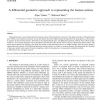25 search results - page 1 / 5 » Neural Mechanisms for Representing Surface and Contour Featu... |
NEUROSCIENCE
2001
Springer
14 years 1 months ago
2001
Springer
Contours and surfaces are basic qualities which are processed by the visual system to aid the successful behavior of autonomous beings within the environment. There is increasing e...
CVIU
2008
13 years 9 months ago
2008
This paper presents a novel representation for human actions which encodes the variations in the shape and motion of the performing actor. When an actor performs an action, at eac...
AVSS
2007
IEEE
14 years 3 months ago
2007
IEEE
Face localization using neural network is presented in this communication. Neural network was trained with two different kinds of feature parameters vectors; Zernike moments and E...
IJCNN
2006
IEEE
14 years 3 months ago
2006
IEEE
—Signatures continue to be an important biometric for authenticating the identity of human beings. This paper presents an effective method to perform off-line signature verificat...
BC
2005
13 years 9 months ago
2005
Abstract Weproposeacomputationalmodelofcontourintegration for visual saliency. The model uses biologically plausible devices to simulate how the representations of elements aligned...

